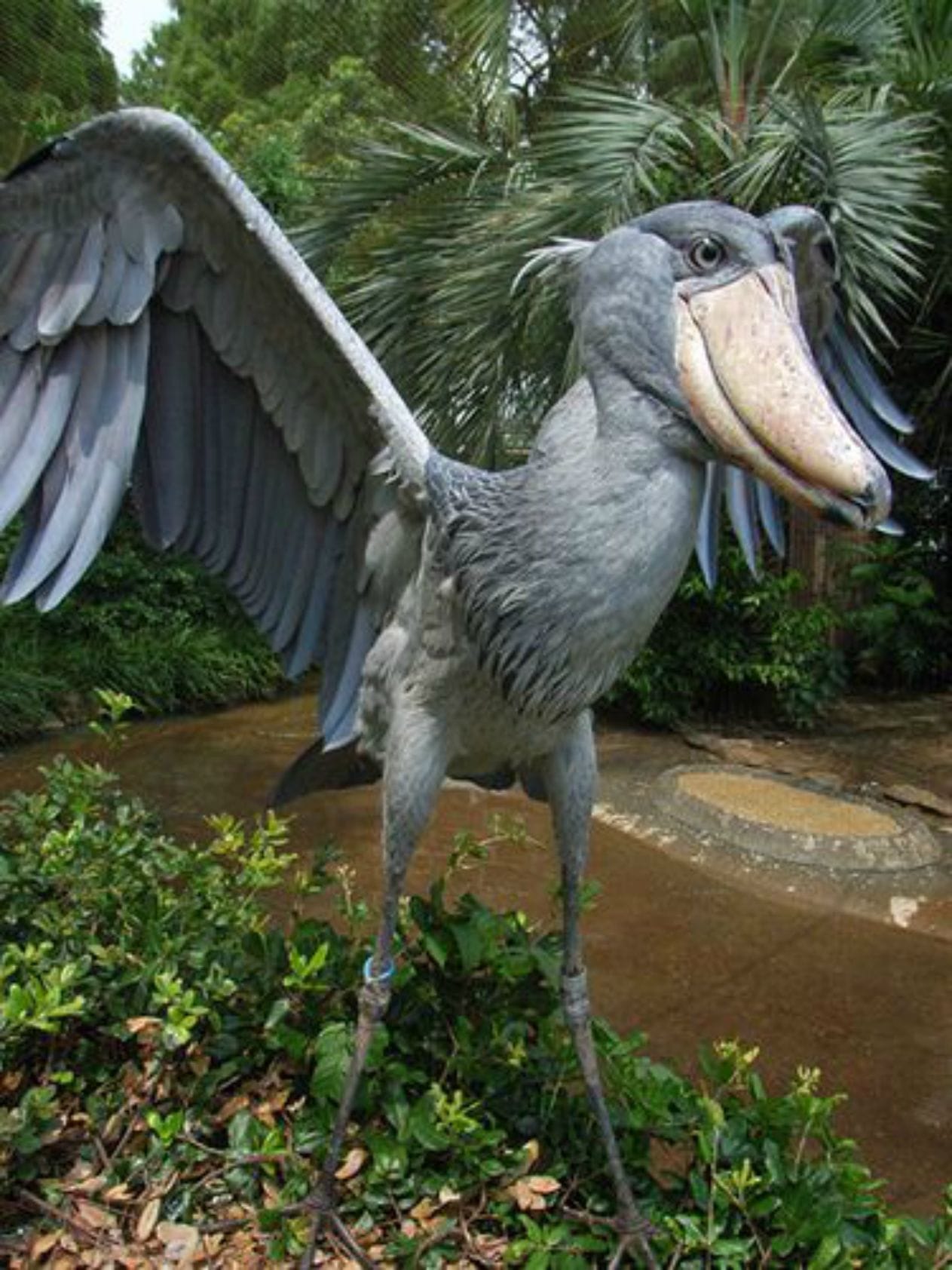Get ready for an auditory adventure as we explore the captivating soundscape of the shoebill stork. This giant of the African wetlands, with a beak that clatters like a machine gun, has a story to tell–a story etched in its unique vocalizations. Join us as we decode the mechanics of these intriguing noises, delve into their significance in shoebill society, and trace their evolutionary journey. Prepare to be amazed by the sonic wonders of the shoebill stork, a testament to nature’s creativity.
Shoebill Stork Sounds: Unlocking the Secrets of their Noisy Nature
Imagine trekking through a humid African swamp, surrounded by the symphony of exotic bird calls. Suddenly, a sound cuts through the air – a rapid, rhythmic clattering, almost like a machine gun firing in the distance. That, my friend, is the unforgettable sound of the shoebill stork.
These birds seem like they’ve stepped straight out of prehistory with their massive size and enormous, clog-like beaks (hence their name!). But their appearance isn’t the only thing that sets them apart–it’s their bizarre and wonderful vocabulary.
That machine-gun clatter? That’s the shoebill’s signature move. Picture snapping your fingers at lightning speed, but with a beak the size of your forearm. Loud, startling, and echoing through the swamp, scientists believe this sound serves a multitude of purposes, from attracting mates and warning off rivals to communicating with their chicks.
But the shoebill isn’t a one-trick pony. Their vocal repertoire extends far beyond the clatter, encompassing a range of hisses, croaks, and even sounds reminiscent of a cow’s moo! These vocalizations, along with their bill-clattering, provide a glimpse into the complex social world of these enigmatic birds.
Why Do Shoebill Storks Make That Noise?
That crazy clattering sound? It’s not just for show–it’s their way of talking! Think of it as the shoebill equivalent of clapping to get attention. They use it to express a range of emotions and intentions, from excitement and aggression to wooing a potential mate.
But the bill-clattering is just the tip of the iceberg. Shoebills possess a surprisingly diverse vocal repertoire, including croaks, hiccups, and even sounds that resemble a cow’s moo! They also engage in gular fluttering, rapidly vibrating their throats to stay cool in the African heat. This adaptation not only helps them regulate their temperature but may also play a role in communication.
Those booming calls serve a vital purpose beyond just making themselves heard. These low-frequency sounds can travel long distances across their wetland homes, acting like a bird-world loudspeaker. It’s how they establish dominance and, of course, try to impress potential mates. These calls are essential to their survival, helping them defend their territory and ensure the continuation of their lineage.
The world of shoebill communication is still being unraveled. Scientists are continually making new discoveries about these fascinating creatures and how they use sound to navigate their world. So, the next time you hear a shoebill’s call, remember that there’s a whole conversation happening beneath the surface.
Are Shoebill Storks Friendly?
It’s understandable to wonder if those prehistoric-looking shoebill storks are as scary as they seem. With their massive size and beaks that could rival a dinosaur’s, they definitely project an aura of intimidation. But are they truly friendly?
While shoebill storks aren’t generally aggressive towards humans, it’s important to remember that they are wild animals with their own set of instincts and behaviors, especially when it comes to protecting their young and territory.
Shoebills are all about personal space, particularly during nesting season. They are fiercely protective parents and will defend their territory, including their chicks, from anything they perceive as a threat. While attacks on humans are extremely rare, it’s always best to admire these impressive birds from a safe distance.
That startling machine-gun clatter? It’s actually their way of communicating, not preparing for an attack. Just like we talk to our friends and family, shoebills use bill-clattering, along with a variety of other vocalizations, to share information and convey their intentions.
While we might be curious about their feelings toward humans, shoebill populations are facing a much bigger threat: habitat loss. As humans continue to encroach upon their wetland homes, shoebills are running out of places to live and raise their young. The best way to ensure the survival of these amazing creatures is to support organizations dedicated to protecting their wetland habitats.
Shoebill Safety 101
- Give them space: Never approach a shoebill nest.
- Hands off! Do not try to touch or feed a shoebill in the wild.
- Keep your distance: Observe them from afar using binoculars or a zoom lens.
- Be mindful: Be aware of your surroundings and try not to startle them.
So, are shoebill storks friendly? They’re not out to get us, but they’re not looking for human companionship either. By understanding their behavior, respecting their space, and supporting conservation efforts, we can help ensure that these magnificent birds continue to thrive for generations to come.
Is the Shoebill Stork a Dinosaur?
The shoebill stork’s prehistoric appearance and strange sounds have led many to wonder: Is it a dinosaur? While they might resemble creatures from a bygone era, shoebill storks are undoubtedly birds, belonging to the class Aves, which encompasses all bird species we see today.
However, they do share a common ancestor with dinosaurs far back in time. Imagine a family tree stretching back millions of years – dinosaurs occupy one branch, while shoebills are on a distant branch, with that common ancestor connecting them in the distant past.
Their dinosaur-like features can be attributed to convergent evolution. This fascinating process occurs when animals living in similar environments and facing similar challenges evolve similar traits, even if they aren’t closely related. For example, sharks (fish) and dolphins (mammals) both developed streamlined bodies and fins due to their aquatic environments.
Similarly, the shoebill’s impressive size and powerful beak are perfectly suited for their wetland habitat, just as certain dinosaur features were adapted for their specific environments. While shoebills didn’t inherit these traits directly from dinosaurs, they both developed similar solutions to similar problems through the forces of natural selection.
And what about that strange, unbirdlike sound they make? Shoebills create that sound by snapping their beaks together, not by using vocal cords like most birds. This beak-snapping serves similar purposes to bird songs, aiding in communication, mate attraction, and territorial defense.
While their appearance might be intimidating, shoebills are generally peaceful towards humans. However, it’s crucial to remember that they are still wild animals and deserve our respect and distance.
The shoebill stork is a captivating example of evolution’s remarkable power. They remind us that the natural world is full of wonder and that glimpses into a distant past can be found in the creatures that share our planet today.
Shoebill Stork Fun Facts
- Crocodile Cuisine: Shoebill storks are skilled predators known to eat crocodiles, among other prey. Check out this amazing video: shoebill stork eats crocodile
- Venomous Neighbors: Shoebills share their habitat with a variety of fascinating creatures, including the venomous sharptail snake. Learn more about this intriguing reptile here: sharptail snake
Important Points About Shoebill Storks
- Bill-Clattering: Their distinctive “machine-gun clattering” is a form of non-vocal communication produced by rapidly snapping their beaks together.
- Vocal Variety: Beyond the clatter, shoebills possess a surprisingly diverse vocal repertoire, including croaks, hiccups, moos, and booms.
- Gular Fluttering: Lacking sweat glands, they use gular fluttering – a rapid throat vibration – to regulate their body temperature.
- Powerful Communication: Their booming vocalizations, adapted for long-distance communication, are essential for establishing dominance and attracting mates.
- Scientific Significance: Their unique sounds and behaviors make them a subject of ongoing research, particularly in the fields of animal communication and acoustics.
- Conservation Concerns: Habitat loss poses a significant threat to shoebill stork populations, making conservation efforts crucial for their survival.
- SYBAU See You Baby Meaning: Gen Z Slang Evolves - July 1, 2025
- Unlock Your Inner Youth: Lifestyle Secrets for a Vibrant Life - July 1, 2025
- Decode SYBAU Meaning: Gen Z Slang Explained - July 1, 2025







1 thought on “The Remarkable Sound of the Shoebill Stork”
Comments are closed.